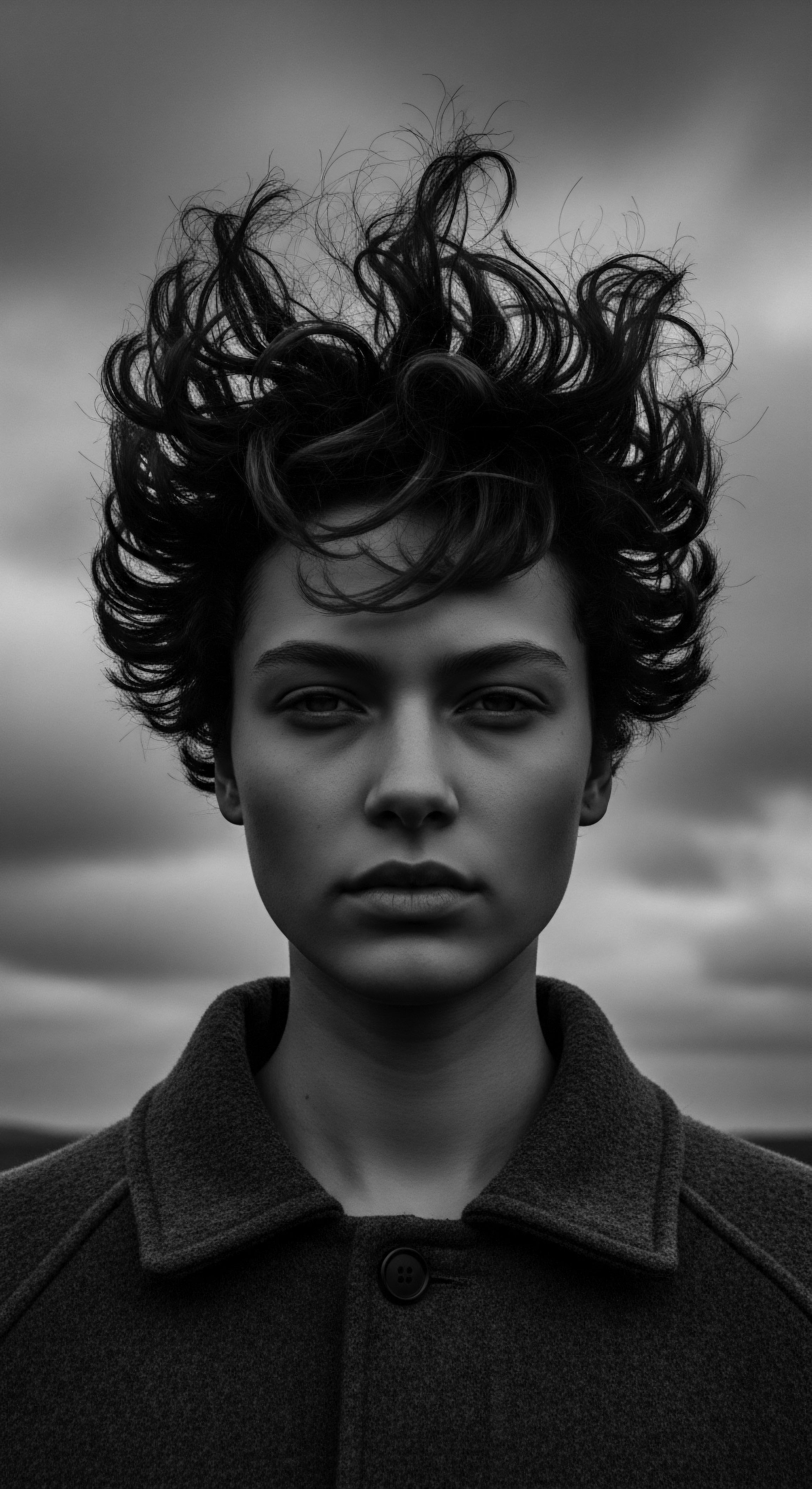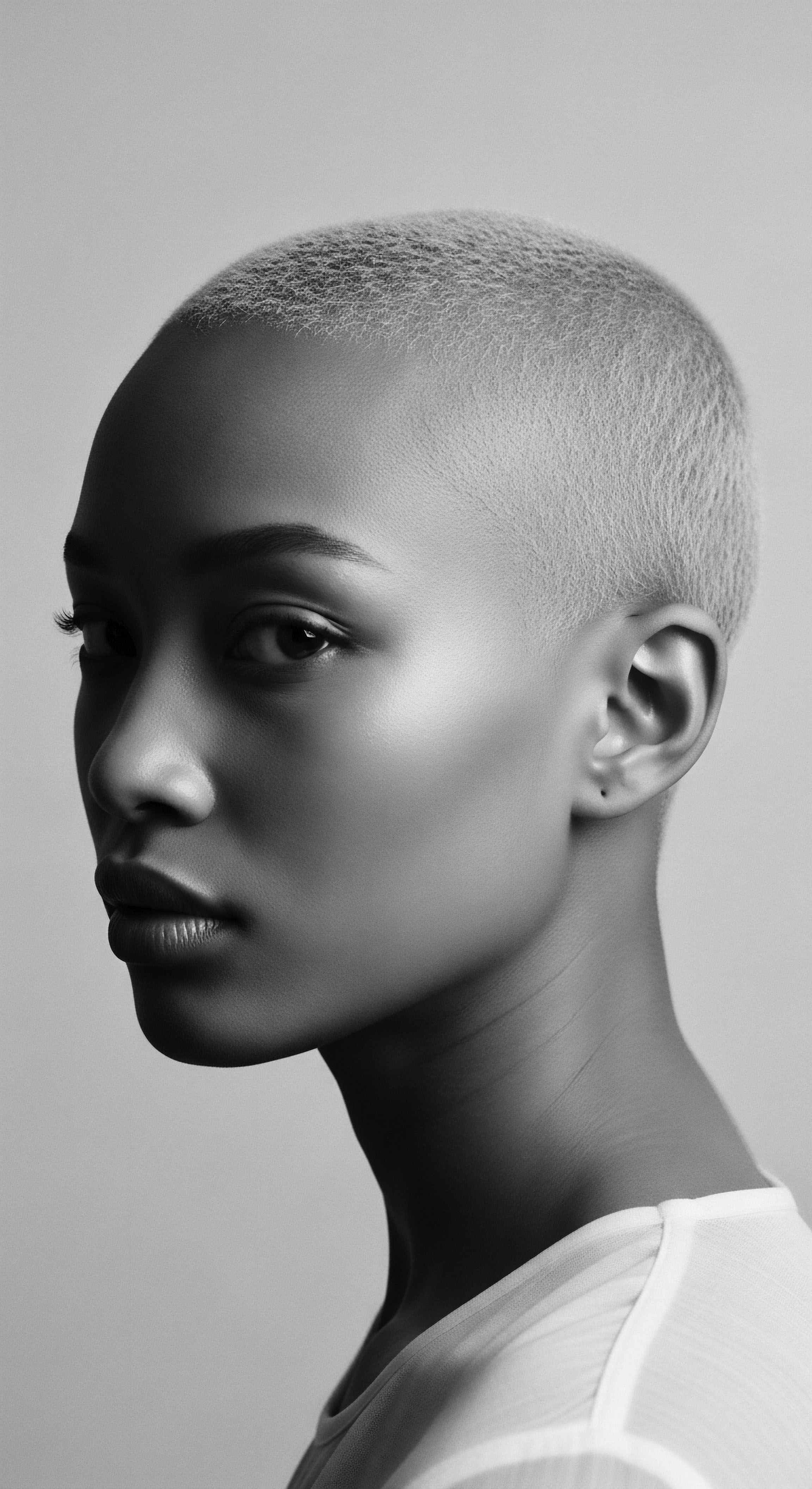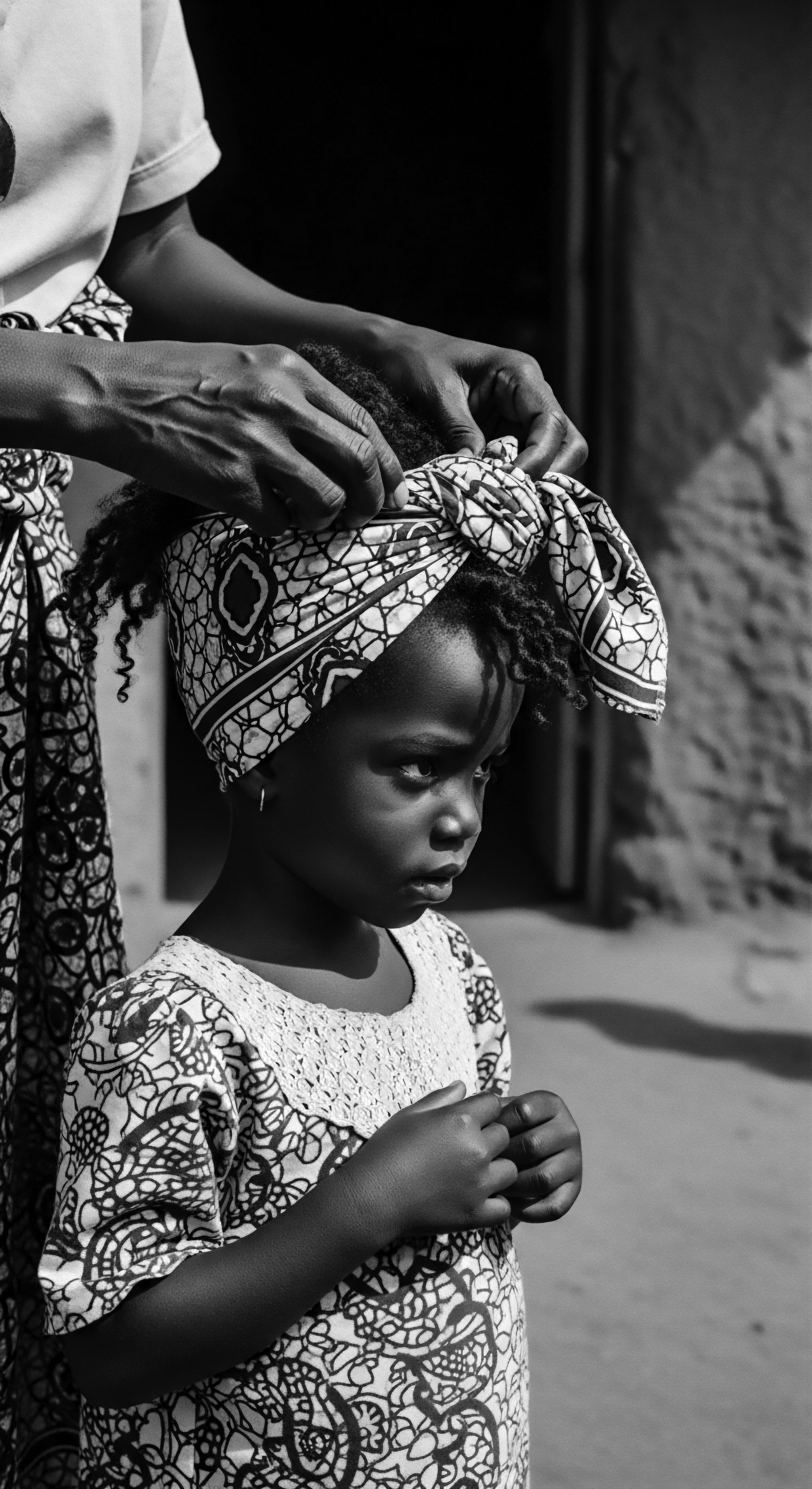
Roots
For Black women, the simple act of covering one’s head carries stories etched in the very helix of their being, narratives stretching back to ancestral lands and woven through the enduring spirit of diasporic communities. It is a whisper from the past, a vibrant echo that speaks of protection, identity, and a sacred connection to the strands that crown them. This custom is not a mere adornment; it is a repository of shared memory, a shield, and a declaration of selfhood, deeply intertwined with the heritage of textured hair itself. Every fold of fabric, every carefully placed wrap, is a testament to the resilience and profound cultural wisdom passed through generations.

Ancestral Veilings
Across various African societies, head coverings pre-dated transatlantic encounters, holding multifaceted significances. In ancient Kemet, for instance, royal and priestly women draped their heads in intricate designs, sometimes adorned with Uraeus symbols, denoting spiritual authority and divine connection. These were not just items of dress; they were extensions of a woman’s spiritual power and her place within the cosmic order.
The very act of concealing or adorning the hair spoke to a reverence for the head as a spiritual conduit, a vessel for wisdom and intuition. The textures of hair, from tight coils to looser waves, dictated the methods of wrapping and the fabrics chosen, each style a nuanced language in itself.
In West African traditions, particularly among the Yoruba, Igbo, and Ashanti peoples, headwraps, known by names such as Gele or Duku, conveyed a woman’s marital status, age, wealth, and community affiliation. A young maiden might wear a simple tie, while a married woman of status would drape an elaborate edifice, often signifying her prosperity and social standing. The fabric itself, whether hand-woven Kente or finely spun cotton, bore its own symbolism, its patterns and colors telling a tale of lineage, celebration, or sorrow.
This was a language understood without words, communicated through the artistry of the wrap. The deep cultural insight into hair, its vulnerability, and its sacred nature informed these early practices, recognizing hair as a living extension of one’s being and heritage.
The tradition of head coverings among Black women is a living archive, each fold a page in the grand tale of ancestral wisdom and resilience.

Anatomical Reverence
From a scientific perspective, textured hair possesses unique structural characteristics that historically benefited from protective styling, including head coverings. The coiled or zigzag patterns of Afro-textured hair mean its cuticle layers are more exposed and prone to dryness and breakage compared to straighter hair types. Ancestral practices, honed over millennia, instinctively recognized this biological reality.
Head coverings shielded delicate strands from harsh elements—scorching sun, drying winds, abrasive dust—preserving moisture and maintaining structural integrity. This practical function undergirded the symbolic meanings, establishing the head covering as a tool for physical preservation as well as cultural expression.
Consider the microscopic view of a single coiled strand. Its elliptical shape and uneven distribution of disulfide bonds render it inherently more fragile at its curves. Protecting this delicate architecture from environmental stressors became an imperative, a practice passed down through generations.
These protective measures allowed hair to thrive in varied climates, demonstrating an innate understanding of hair biology that predates modern trichology. This ancestral knowledge, deeply rooted in observing and adapting to the hair’s intrinsic needs, forms the initial connection between head coverings and the fundamental understanding of textured hair, echoing through time.
| Term Gele |
| Region/People Yoruba (Nigeria) |
| Cultural or Practical Aspect Often elaborate, signifies marital status, celebration, social standing. |
| Term Duku |
| Region/People Ghana, Malawi |
| Cultural or Practical Aspect Daily wear, religious observance, sign of respect. |
| Term Dhuku |
| Region/People Zimbabwe |
| Cultural or Practical Aspect Similar to Duku, can signify modesty or protection from sun/dust. |
| Term Tukwi |
| Region/People Botswana |
| Cultural or Practical Aspect Practical protection for hair, cultural adornment. |
| Term Doek |
| Region/People Southern Africa (Afrikaans influence) |
| Cultural or Practical Aspect General term for headscarf, used for various purposes including respect and identity. |
| Term These terms reflect the diverse heritage of head covering traditions across the African continent. |

Ritual
The use of head coverings evolved from essential protection to a powerful form of cultural expression and resistance, shaping the very language of textured hair styling. In the forced migrations across the Middle Passage, head wraps became a means of maintaining dignity and cultural continuity amidst unimaginable adversity. Stripped of their ancestral adornments and practices, enslaved Black women transmuted simple cloth into symbols of enduring spirit.
The act of tying a head wrap became a quiet act of defiance, a way to reclaim selfhood when every other aspect of one’s being was denied. This historical turn solidifies head coverings as a central element of Black women’s hair heritage.

Styling Resilience
Head coverings served as the earliest protective styling. They shielded coils and kinks from the rigors of forced labor, protecting hair from dust, grime, and the harsh sun. The pragmatic need for hair maintenance under oppressive conditions gave rise to innovative uses of limited resources. While practical, these practices never lost their inherent artistry.
The way a head wrap was tied, the colors chosen, and the textures combined, all communicated nuanced messages within the enslaved community, invisible to the enslavers. It was a secret language of visual cues, a defiant preservation of aesthetic and cultural memory. These techniques provided a groundwork for what we now recognize as protective styles, allowing hair to rest, grow, and flourish beneath layers of fabric, preserving its inherent characteristics.
An undeniable historical example of this defiant artistry lies in the Tignon Laws of Louisiana. In 1786, Spanish colonial Governor Esteban Rodríguez Miró enacted a decree, formally titled the “bando de buen gobierno,” which mandated that free women of color in New Orleans wear a tignon or headscarf. This ordinance aimed to restrict their perceived influence and status, specifically by concealing their elaborate hairstyles which were considered too attractive and competitive with white women’s fashion (Gould, 1996). The intent was to visually mark them as belonging to a lower social stratum, linking them to enslaved women who wore head coverings for utilitarian purposes.
However, Black women, ever ingenious, subverted the law’s intent. They transformed the mandated tignon into an iconic statement of style and defiance. Rather than simple, unassuming coverings, they procured the finest, most vibrant fabrics—silks, satins, and brocades—and tied them in intricate, towering configurations, adorning them with feathers and jewels. What was meant to diminish them instead became a bold declaration of their beauty, wealth, and undeniable creative spirit.
This act of reclaiming the head covering as a symbol of identity, artistry, and rebellion is a profound cornerstone of textured hair heritage, underscoring its role beyond mere concealment. It demonstrates how a tool of oppression was transformed into a conduit for cultural affirmation.
Head coverings transcend simple utility, standing as a testament to the creative spirit and defiant beauty maintained through generations of Black women.

The Fabric of Identity
The relationship between head coverings and wigs or extensions in historical contexts further deepens this exploration. In some African societies, elaborate hair structures, sometimes incorporating extensions of plant fibers or animal hair, were themselves draped or adorned. The covering became a complementary element, enhancing the overall presentation of identity and status.
In the diaspora, especially after the Tignon Laws and the ensuing shifts in beauty standards, head coverings continued to shield hair from manipulation or served as a stylistic alternative to conform to Eurocentric ideals. They allowed women to protect their natural hair underneath while navigating societal pressures.
This interplay reveals the adaptability of Black women’s haircare practices. The head covering became a versatile tool, at times a statement of pride, at others a practical solution for hair health, and sometimes a strategic maneuver to blend or distinguish. Its enduring presence in the toolkit of textured hair care speaks volumes about its utility and its deep cultural resonance.
- Protection ❉ Shielding hair from environmental damage, maintaining moisture, preventing breakage.
- Expression ❉ Signaling social status, marital standing, spiritual belief, or personal style.
- Resistance ❉ Subverting oppressive mandates, reclaiming autonomy over one’s appearance.
- Community ❉ Fostering shared identity, unspoken communication within a group.

Relay
The ancestral meanings held by head coverings for Black women carry forward, informing contemporary practices of holistic hair care, nighttime rituals, and problem-solving. These practices resonate with the deep wisdom of those who came before, recognizing hair not only as a biological structure but as a sacred extension of the self. The continuous journey of the head covering, from a means of survival to a celebrated emblem of heritage, speaks to its enduring wisdom in nurturing the hair and spirit.

Nighttime Sanctuaries
Modern understanding of textured hair’s fragility reinforces the ancestral wisdom of protection, especially during sleep. Cotton pillowcases, with their absorbent nature and coarse fibers, can draw moisture from hair and create friction, leading to dryness, frizz, and breakage. This is particularly harmful for delicate coils. Ancestral practices instinctively understood the need to protect hair from such nightly aggressions.
While specific historical documentation of pre-colonial nighttime coverings is sparse, the pervasive use of wraps and bonnets in post-enslavement contexts points to an inherited knowledge of hair preservation. The Satin Bonnet and silk scarf, prevalent today, are direct descendants of this protective ethos, safeguarding hair’s moisture and preventing tangles that could unravel carefully crafted styles or damage fragile strands. This contemporary practice bridges the gap between historical necessity and modern hair science, proving the enduring value of ancestral care.
The simple act of wrapping the hair before sleep, whether with a delicate scarf or a structured bonnet, is a quiet ritual of care. It honors the strands, preparing them for the day ahead by minimizing disturbance and preserving the scalp’s natural oils. This is a practice passed down from mothers, grandmothers, and community elders, a testament to the shared understanding that hair, like a precious garden, requires mindful attention and a nightly haven. This sustained practice of protecting hair at night, a seemingly simple act, holds generations of wisdom concerning the longevity and health of textured hair.

Ingredients and Holistic Wellness
The materials used for head coverings, both historically and presently, speak to a deep understanding of natural resources and their benefits. Early wraps might have been fashioned from locally sourced plant fibers, later incorporating trade cloths of silk, cotton, or linen. Each material possesses distinct qualities ❉ cotton breathes, silk reduces friction, and linen offers durability. The choice of material for a head covering was not accidental; it was a deliberate selection rooted in function and aesthetic.
This attention to material mirrors the ancestral approach to hair care ingredients. Traditional remedies often involved plant-based oils, butters, and herbs—substances that nourished the hair and scalp. The holistic practitioner within the Roothea ethos recognizes that the external protection offered by a head covering works in concert with internal wellness and topical nourishment.
Hydration, balanced nutrition, and gentle handling form a holistic regimen that ancestral wisdom inherently understood. The head covering, in this light, becomes part of a larger continuum of care that respects the hair’s biological needs and its cultural heritage.
| Benefit Area Moisture Retention |
| Traditional Understanding (Heritage) Shielded hair from drying sun and wind. Preserved natural oils for soft strands. |
| Modern Understanding (Science) Reduces evaporation from hair shaft. Prevents product absorption by fabrics like cotton. |
| Benefit Area Reduced Breakage |
| Traditional Understanding (Heritage) Kept hair contained, preventing tangles from daily tasks or sleep. |
| Modern Understanding (Science) Minimizes friction against clothes, furniture, or bedding, protecting cuticle. |
| Benefit Area Styling Longevity |
| Traditional Understanding (Heritage) Maintained elaborate styles for days, extending their wear and symbolism. |
| Modern Understanding (Science) Preserves curl pattern, prevents frizz, reduces need for frequent restyling. |
| Benefit Area Scalp Health |
| Traditional Understanding (Heritage) Protected scalp from direct sun, kept it clean from dust and debris. |
| Modern Understanding (Science) Prevents direct UV exposure. Reduces environmental pollutants settling on scalp. |
| Benefit Area Head coverings consistently serve a dual purpose, blending ancestral wisdom with validated scientific benefits. |

How do Head Coverings Aid in Protecting Delicate Hair Textures from Environmental Stressors?
The inherent structure of textured hair, with its unique bends and twists, renders it more vulnerable to environmental damage compared to straight hair types. Head coverings act as a physical barrier, significantly reducing exposure to elements that can deplete hair’s moisture and compromise its structural integrity. Direct sunlight can degrade the hair’s protein structure and dry out strands, leading to a loss of elasticity. Wind, too, can cause tangling and friction, contributing to breakage.
A head covering, whether a simple scarf or an ornate wrap, creates a microclimate around the hair, shielding it from these external aggressors. This protective layer helps to seal in moisture from conditioners and stylers, allowing the hair to remain hydrated for longer periods. It also prevents dirt, dust, and pollutants from settling on the hair and scalp, which can clog follicles and contribute to irritation or dryness. This foundational principle of environmental protection, deeply ingrained in ancestral practices, remains a primary reason for the continued adoption of head coverings today, demonstrating a continuous thread of care that connects ancient wisdom to modern hair health.
The seamless blend of ancestral wisdom and scientific validation anchors the head covering’s enduring utility in daily hair care.
Head coverings also assist in managing shedding and keeping hair contained during various activities, a practical aspect often overlooked. For those with long or dense textured hair, a well-placed wrap can minimize snagging on clothing or other surfaces. This functional advantage, honed over centuries of daily life, underscores the pragmatic genius behind their continued use, a quiet yet powerful heritage of care.

Reflection
The journey of head coverings for Black women, from the ancient adornments of African royalty to the defiant tignons of New Orleans, culminates in a rich tapestry of meaning that continues to evolve. Each thread in this history tells a story of protection, resilience, identity, and an unwavering connection to textured hair heritage. It is a dialogue between past and present, a quiet conversation that whispers of ancestral wisdom while adapting to contemporary needs. The spirit of a strand, as Roothea understands it, is never isolated; it is always connected to a collective memory, a legacy of care and defiance.
The head covering, therefore, is not merely an accessory; it is a sacred vessel, a living archive of a people’s strength and beauty. It stands as a profound symbol, reminding us that true wellness stems from a deep appreciation of our roots, our rituals, and the stories we relay through our hair.

References
- Gould, Virginia M. (1996). Chained to the Rock ❉ Slave Women and Their Search for Freedom in Colonial Louisiana. University of North Carolina Press.
- Opoku, A. A. (2018). African Traditional Hairdressing ❉ A Study of Its Cultural Significance. Ghana Universities Press.
- Sweet, R. (2003). The Headwrap ❉ A Cultural and Aesthetic Expression. Black Classic Press.
- Grier, P. M. (2004). Women and Their Hair ❉ A Cultural History. Duke University Press.
- Byrd, A. D. & Tharps, L. L. (2001). Hair Story ❉ Untangling the Roots of Black Hair in America. St. Martin’s Press.
- Rastogi, S. & Sharma, M. (2014). Hair ❉ A Cultural History. Berg Publishers.
- White, D. (2006). Slave Narratives ❉ A Resource Book. Oxford University Press.
- Gates Jr. H. L. & West, C. (1999). The African-American Century ❉ How Black Americans Have Shaped Our Country. Free Press.
